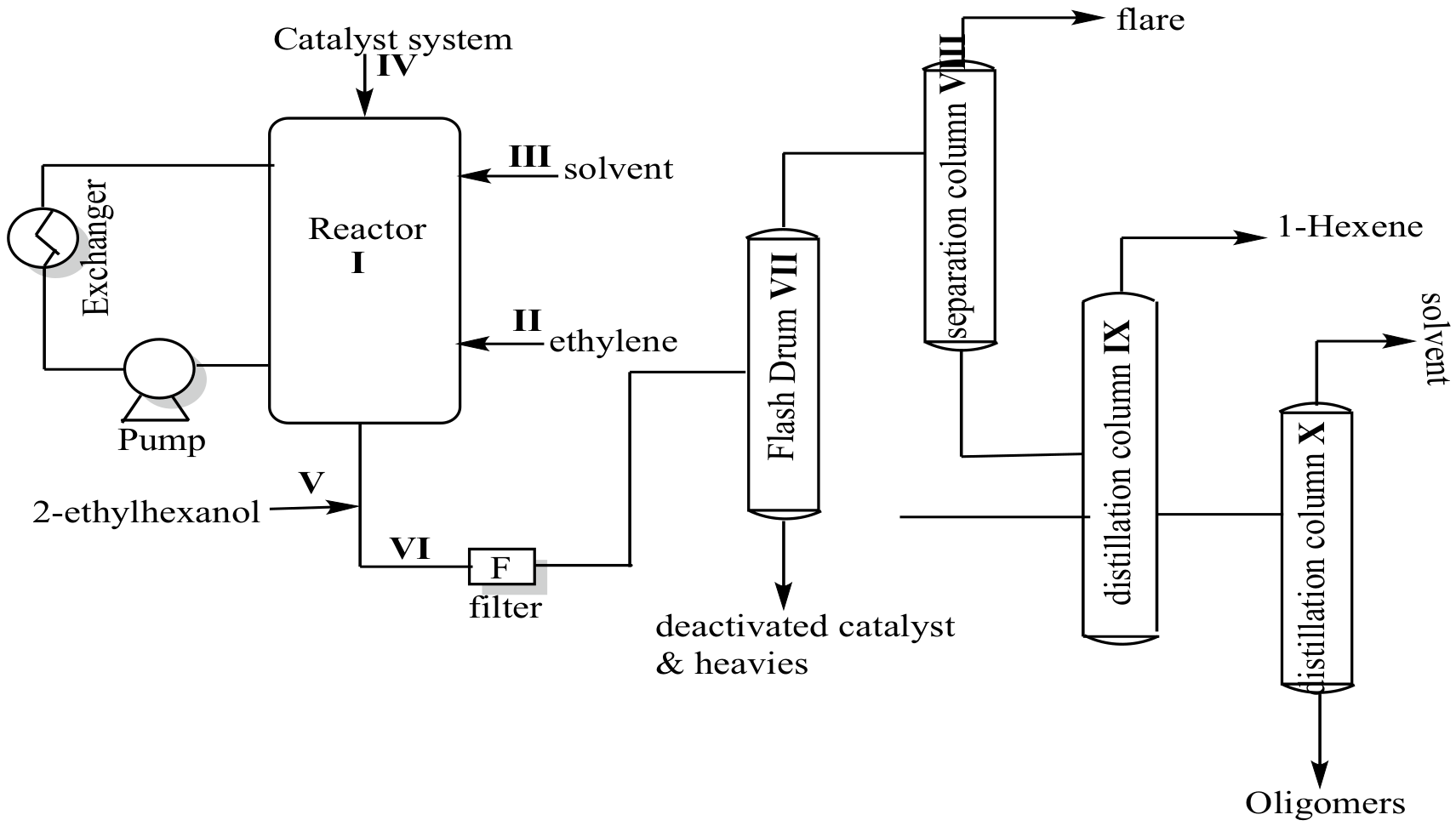ppPLUS: Technologies and more
Go to Homepage to browse companies and process data
ppPLUS-Solutions providing Services and Support
Register creating your own models
Technology
- Name
- CPChem 1-Hexene
- Owner
-
/ Chevron Phillips Chemical Company LLC - Brand
- 1-Hexene Technology
- Process
- Olefin processes
- Type
- Ethylene Oligomerization
- Available
-
Chevron Phillips is the leading supplier of 1-Hexene due to their successful Trimerization Technology utilizing Chromium-Pyrrole Catalyst System.[1]
The Reaction usually occurs in Bubble Column Reactor I to which Polymer Grade Ethylene is fed through Inlet Line II from the Bottom of the Reactor. The Solvent (Cyclohexane) is pumped using Inlet Line III. The Catalyst System consisting of Cr(EH)3/ DMP/ Et3Al/ AlEt2Cl is introduced to reactor through Inlet Line IV. The Reactor Temperature is maintained at 115°C by Water cooled Exchanger. The Reactor pressure is maintained at 800 psi during Trimerization Reaction with residence time of 4–6 h. 1-Hexene is formed in the Reactor with high selectivity and additionally small amount of higher olefins such as Octene, Decenes, Polymer, etc. are also formed through unavoidable Side Reaction. Trimerization Reactor Effluent comprising 1-Hexene, other Alpha Olefins, Polymers, Unreacted Ethylene and Catalyst Residues is removed via Effluent Line VI. The Stream of 2-Ethylhexanol is fed via Inlet Line V into effluent line VI to deactivate the Catalyst System. A Filter can be used to remove Solid Particles such as undesirable Polymer, Catalyst Residues, etc. from Effluent Line VI. If the Reactor Effluent Stream in Effluent Line VI is maintained at a temperature above the melt temperature of the Polymer, then Filter may not be useful to trap the Polymer By-Product. However, if the Reactor Effluent Stream in Effluent Line VI is allowed to cool, Polymer By-Product precipitates out and Filter can be used to separate them. The Reactor Effluent is next pumped to Flash Drum VII where Catalyst Residues and other Heavies are separated from Lighter Olefins and Reaction Solvent. The Bottom Portion of Flash Drum is connected to downstream Processing Unit to remove the Heavy Oligomers, Polymers and Catalyst Residues. Reactor Effluent is pumped to Ethylene Recovery Unit VIII where Ethylene is separated and sent back to either Reactor or Flare Unit. Distillation Column IX is used to separate desired 1-Hexene. Next, Cyclohexane and other higher Oligomers are sent to Distillation Column X. The Cyclohexane is separated and sent back to the reactor for Reuse.[1]
1. Salian, S.M., Bagui, M. & Jasra, R.V. Industrially relevant ethylene trimerization catalysts and processes. Appl Petrochem Res 11, 267–279 (2021). https://doi.org/10.1007/s13203-021-00279-7
- Link
System Info
- Updated by
-
 Kokel, Nicolas
Kokel, Nicolas - Updated
- 1/1/2023 2:30 PM
- Added by
-
 Kokel, Nicolas
Kokel, Nicolas
- Added
- 1/1/2023 8:59 AM

No Services yet available.
Enquire in Solutions how we can help you.
| Technology Unit |
|---|
| Distillation Column |
| Flash Drum |
| Reactor |
| Separation Column |
| Entity | Site (Country) | Asset (Plant) | |||
|---|---|---|---|---|---|

|

|
|
1-Hexene Plant | ||

|

|
|
1-Hexene Plant |

